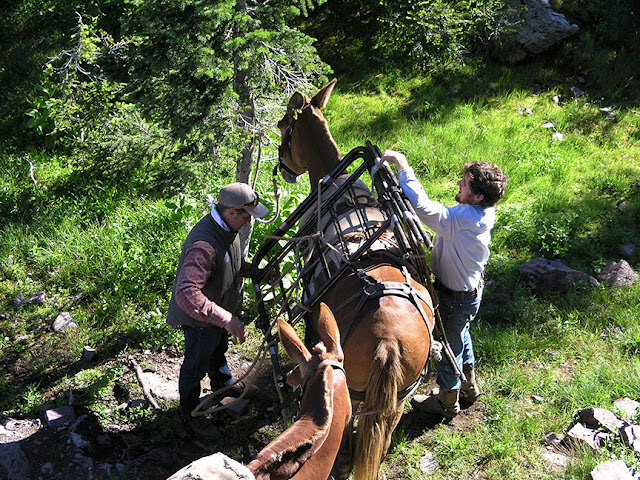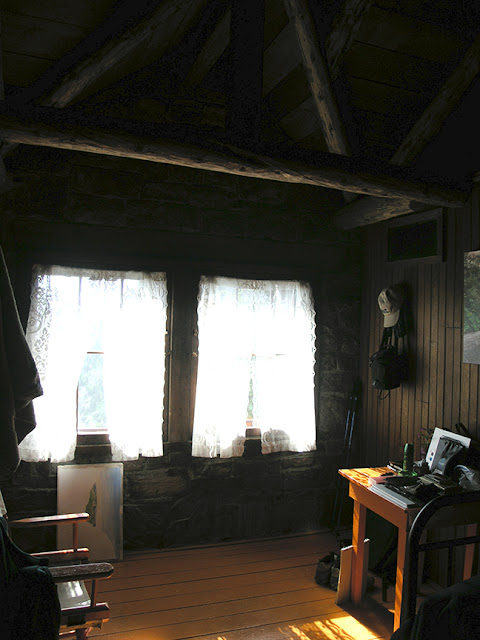 |
| Last light on Gunsight Mountain. |
It was the night of the full moon, and the staff at Sperry Chalet planned to hike up to Lincoln Pass to watch it rise. This would be a spectacular sight in the surroundings, and a number of guests, myself included, intended to join them. But around dinnertime, clouds began to move in from Lake McDonald, and a thunderstorm broke out just as it was getting dark. With rain pouring and lightning strikes, calling off the hike was the wise thing to do--we wouldn't have seen the moon in any case.
It got very cold after the storm, and I was glad to have four wool blankets on my bed to tuck under. The next morning was clear but so icy, I put on several layers under my new vest and old Polartec jacket to walk down for breakfast. After breakfast I got out my watercolor kit and began to formulate a plan for painting a watercolor of the view from Sperry Chalet...
 |
| The view from Sperry Chalet. |
From these heights all that could be seen of Lake McDonald below was one small pale blue oval, but looking down the mountain peaks and crags from either side, and then the receding ranges of mountains on the other shore of the lake, this was a magnificent sight, worthy of one of the 19th Century landscape masters!
A few mountain goats grazed near by, so I kept a close eye on my gear, to make sure no goats would be tempted. Sketching out the composition and planning the execution took the better part of an hour, and by the time I'd put in a wash for the sky and defined the farthest mountain ranges, it was getting on towards ten. The shadows had changed too much to continue. I'd have to plan for time each morning to continue my painting.
 |
| My watercolor painting, day 1. |
Two of the ladies on the staff, Karen, the baker, and Stephanie, one of the waitresses, had their scheduled afternoon off today, and they invited me to join them for a hike to Ellen Wilson Lake. Gunsight Pass trail goes in the direction opposite to the Sperry Glacier trail--it rises up about 500 feet to Lincoln Pass and then goes down on the other side towards two lakes: Lincoln and Ellen Wilson Lake. The trail then rises again some 6,900 feet to Gunsight Pass and descends towards Lake St. Mary on the other side of the Continental Divide.
We started out around 10:30, walking behind the Chalet and past the Sperry campsite, passing a small pond. My companions joked that they had named it Pond Willie Nelson, a funny acronym of 'Ellen Wilson'. I had a hard time keeping up with my companions-- they weren't even breathing hard on the hike uphill, while I had to stop every thirty paces or so, but they were very patient with me. Today I'd come up with a way to tie my camera around my chest with an old scarf I'd brought along just in case, so that I could keep the camera on my neck and not have it swing from side to side while I walked. This way I could take photos along the way without having to stop to put down my pack, take out the camera, put it back in, etc. which slowed me down so much before.
 |
| Willie Nelson Pond and Sperry Chalet (on the right) from Lincoln Pass. |
 |
| View of Lake McDonald from the top of Lincoln Pass. |
Karen and Stephanie chatted as they walked, and I commented occasionally when I had some breath left. They allowed me to stop frequently to rest and photograph plants, and Karen, who is a wildlife biologist, identified the few birds and other creatures we saw along the way. I asked them to point out the huckleberry plants, which I hadn't been able to identify with any certainty. I was surprised to learn one variety was so tiny--it was hard to believe they provided enough food for bears. But Karen said these berries were the sweetest. The plants were just starting to bloom.
 |
| Looking south from Lincoln Pass. |
On the other side of Lincoln Pass the view of a whole new set of mountain ranges opened up. We off-trailed across some rocky ledges overlooking Lincoln Lake, a small blue-green circle with towering cliffs looming above it. The lake sat in a narrow bowl, and Karen said going down there would make her uneasy, it seemed like the perfect habitat for bears, where one could easily get trapped.
 |
| Lincoln Lake. |
Hiking downhill towards the Lake Ellen Wilson overlook, we came across many lovely wildflowers: a flat area still soaked with recent snow-melt had large clumps of low-growing Bog Laurel (
Kalmia polifolia) and pink mountain heather (
Phyllodoce empetriformis), farther on yellow cinquefoil and elliptical-leaf Pentstemon grew in patches among the rocks.
 |
| Bog laurel (Kalmia polifolia) |
 |
| Pink Mountain Heather (Phyllodoce empetriformis) |
 |
| Pentstemon ellipticus |
Lake Ellen Wilson came into view as we rounded another bend. The wind was frothing the surface of the glacial water, and cut into us like an icy knife as we walked out into the open. I was glad to have packed my Polartec vest and nylon jacket, and slipped them on immediately. My friends did the same with their gear--here was the practical illustration of why one should follow mountaineering advice.
 |
| Lake Ellen Wilson looking towards Gunsight Pass. |
 |
| Lake Ellen Wilson from the overlook. |
We would have been shivering miserably in our sweaty T-shirts if we hadn't had extra layers of warm clothing. Instead, we settled down on the rock to enjoy lunch in this marvelous spot! The overlook was marked by a huge rock and from it we could survey the oval lake with several long, thin waterfalls emptying into it and Gunsight Pass beyond. The sound of the wind and the occasional cry of a bird were interrupted once or twice by the noise of the helicopter tours overhead.
 |
| Karen |
 |
| Stephanie |
After a leisurely lunch we started back--my companions had to be back by four to work on their dinner chores. On the way back we spotted one lonely Mariposa lily blooming along a rocky embankment. I was surprised to find it in this environment, as I thought this flower was strictly a denizen of warmer climates .
 |
| Mariposa lily (Calochortus apiculatus) |


















































